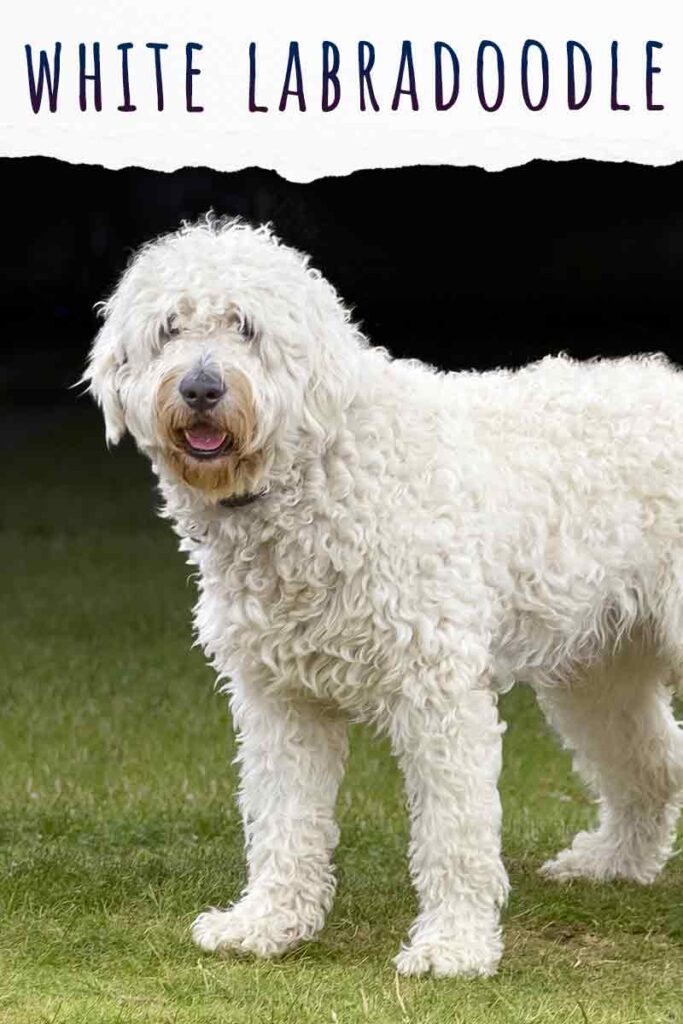The white Labradoodle is a friendly, outgoing and active dog. They make great family pets in the right home, but do need lots of attention. Exercise, training, and lots of work keeping that lovely coat sparkling, are essential!
A fully white Labradoodle will usually get their color from the S gene, also known as the spotting gene. But, in some circumstances, they may have albinism. Sometimes, white fur can be caused by health problems, such as vitiligo or anxiety. But, these Labradoodles will not be white from puppyhood.
Pure white Labradoodles are less common than chalk or cream ones. And, in some lighting, chalk, champagne, or cream doodles can look white. Let’s take a closer look at this striking coat color, including the best place to find a white Labradoodle puppy.
White Labradoodle Quick Links
- White Labradoodle genetics
- Albino Labradoodles
- White fur from health problems
- White Labradoodle temperament
- Are white Labradoodles healthy?
- Where to find a white Labradoodle puppy
Whether you’ve got a pure white Labradoodle at home, or you’re eager to find one of these puppies, this guide will tell you everything you need to know.
White Labradoodle Genetics
The two most common ways white Labradoodles get their fur color is through the spotting gene, or albinism. Cream or chalk can look close to white under some types of lighting but will always have more warmth than a pure white.
When it comes to Labradoodle coat genetics, there are two main color pigments: eumelanin and phaeomelanin. Eumelanin in its purest form is basic black and phaeomelanin in its purest form is basic red. Other genes can interact with these pigments to transform basic black or red into other colors along each color spectrum.
One of these genes that can create a white coat is known as the S gene. This S gene is often called the “self” or “spotting” gene. It is a dominant gene, so a Labradoodle puppy only needs to inherit it from one parent in order to show a white coat.
Poodles carry the S gene, but Labradors do not. So, if your Labradoodle’s white coat is caused by the S gene, it will come from their Poodle parent!

Dilute Gene
Sometimes, Labradoodles can appear white if they have the dilute gene over a yellow coat. The dilute gene, as its name suggests, will dilute the pigment in a normal coat color, making it paler. Some examples include the champagne Labrador, which is quite controversial for some people!
Labradoodles with dilute coats may look white. But, they may also be at higher risk of certain health problems, like alopecia.
Premature Greying Gene
Poodles also carry the greying (G) gene. Like the S gene, the G gene is dominant. So, puppies only need to inherit it from one parent to express it.
If a Labradoodle puppy inherits this gene, the pigment in their coat may begin to fade, or turn grey early in life. Depending on their original coat color, premature greying could cause the affected hairs to appear white.
Albino Labradoodles
Albino dogs have absolutely no pigment anywhere on their skin or fur. They are incapable of producing it. Albinism is incredibly rare. If you have a white Labradoodle, it’s most likely that they have the spotting gene, rather than no pigment in their fur.
A dog can look albino in every way and still not be an albino dog. Sometimes, an extreme form of coat color dilution can also cause an albino appearing dog. Some breeds (such as the Doberman) can also have an albino mutation that causes only parts of their body to be true albino.
Albino Labradoodles often have pink paws, nose, lips, and skin around their eyes. Their eyes themselves may also have a pink or red tinge. You can get your dog tested for the albino gene if you suspect they may be albino.
White Fur from Health Problems
The final way that Labradoodles can get white fur is from certain health issues. Two major issues that can cause white fur are vitiligo and stress.
Vitiligo
Vitiligo is a relatively rare skin disease that causes pigment loss. This disease is an immune system malfunction that causes the dog’s body to attach the pigment-producing cells, or melanocytes.
Vitiligo in dogs often starts in young adulthood. It usually shows up first on the face and then spreads to other areas of the body. If one parent dog is a yellow Labrador Retriever, there may be a slightly higher risk of Labradoodle puppies inheriting the gene for vitiligo.
Systemic Stress or Anxiety
Labradoodles are clever, social, and active dogs. But, this means they can be prone to anxiety and stress. Especially if their daily dietary, social, and exercise needs aren’t met.
Underlying stress is unlikely to cause widespread uniform coat color change. But, it can impact skin and coat health, and make a dog’s natural coat color look less vibrant.
White Labradoodle Temperament
As long as your Labradoodle gets their white coloring from a genetic cause, such as the spotting gene, their temperament will be the same as any other Doodle. They will be clever, friendly, energetic, and affectionate. Especially if they’ve been socialized well. However, if your Labradoodle gets their white coat color from a health issue, there’s a chance they may be more withdrawn than a healthy Labradoodle.
Choose a reputable breeder in order to get Labradoodle puppies with the best possible temperament. You can also ask to meet the parent dogs bred, to get an idea of how your puppy will grow up to be.
Are White Labradoodles Healthy?
The health of your Labradoodle will depend on how they’ve obtained their white coat. For instance, dogs with albinism will need extra care when out in the sun. They are at higher risk of issues like sunburn, which can also increase their risk of tumors or skin cancer.
Albino dogs can also experience vision problems, due to their sensitive eyes. Studies have suggested that white dogs can have a higher risk of deafness and hearing-related health problems. And, as we mentioned earlier, white Doodles with the dilute gene can suffer from alopecia. Other than this, a white Labradoodle will be prone to the same health problems as its parent breeds.
Luckily, choosing a puppy from a reputable breeder can help to minimise health issues later in life.
Where to Find a White Labradoodle Puppy
When looking for a white Labradoodle puppy, choose a reputable breeder. Stay away from puppy mills and backyard breeders. Even with modern research, it’s still not possible to fully predict which genes a puppy will inherit from each parent. But, there are genetic tests that can determine each parent dog’s potential contribution based on their coat color genome.
Your breeder can use these test results to create statistical models, and better predict coat color inheritance in litters. Some breeders may just choose to put you on a waiting list and let you know when a white Doodle comes up.
Different Descriptions
If you’ve been researching Labradoodle coat colors, you’ll notice the references to chalk and cream coat colors. Some breeders use these terms to mean “white”. But, chalk and cream can actually occur on a color spectrum, with some variants appearing lighter or darker.
Remember that the Poodle is the only Labradoodle parent with a white coat color as a standard, show approved color. So, you can also try to choose breeders that are using white Poodles for their Labradoodle puppies. Above all, make sure they health test the parent dogs, and show you clean health certificates.
Do You Have a White Labradoodle?
The white Labradoodle is a less common coat color, but one that many people love. xDo you have a white, cream, or chalk Labradoodle at home? We would love to hear about them!
References and Resources
- Chapelle, J. ‘Intensity Series: Albinism’, Dog Coat Color Genetics (2021)
- Lewis, L. ‘Labradoodle Coat Colours’, The Australian Labradoodle Association (2021)
- Buzhardt, L. ‘Genetics Basics – Coat Color Genetics in Dogs’, VCA Animal Hospitals (2021)
- Ali, M. (et al), ‘Genetic Analysis of the Modern Australian Labradoodle Dog Breed Reveals an Excess of the Poodle Genome’, PLOS Genetics (2020)
- Armstrong, J. ‘Color Genes in the Poodle’, University of Ottawa Department of Biology (1999)
- Boyko, A. ‘Science Corner: Coat Color Genetics 101’, Embark Veterinary (2021)
- Miller, P. & Murphy, C. ‘Vision in Dogs’, Leading Edge of Medicine – A Review (1995)
- Strain, G. ‘Deafness Prevalence and Pigmentation and Gender Associations in Dog Breeds at Risk’, The Veterinary Journal (2004)
- Philipp, U. (et al), ‘Polymorphisms within the Canine MLPH Gene are Associated with Dilute Coat Color in Dogs‘, BMC Genetics (2005)

